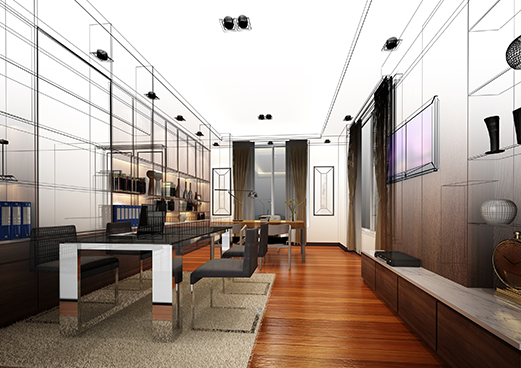Choosing the best rendering engine is paramount for designers and architects alike. Which engine you opt for will impact realism, style of client communication, workflow, and adaptability. In a nutshell, it governs how designs are discerned and communicated.
Whether settling on V-Ray or Corona, there will be an influence over visual appeal in determining the quality of renders. The correct engine for you optimises realism through representative materials, and realistic lighting and shadows, directly affecting client satisfaction, and aiding clear communication throughout the project.
Technology is redefining modern design and architecture, with rendering engines on the frontline. Rendering engines utilise algorithms, driving life-like 3D renders. Client satisfaction is maximised by providing realistic previews and facilitating informed decision-making. Progression through continuous improvements, such as real-time rendering and advanced lighting features, consistently exceeds expectations and makes rendering engines pivotal in shaping the design process.
In this blog post, Elmtec explores some of the myriad differences between two such rendering engines, Corona Render vs V-Ray.

Understanding Corona Render vs V-Ray
Corona Render and V-Ray are market-leading rendering engines. Similarities are witnessed, yet each boasts distinct features.
Corona promotes simplicity and photo-realism, appealing to designers who want an easy-to-use interface. It astounds in interactive rendering and uses adaptive image sampling.
V-Ray is renowned for its versatility. It supports a multitude of 3D modelling software suites such as SketchUp and offers advanced ray tracing and global illumination for realistic lighting effects. The V-Ray Proxy feature efficiently manages complicated scenarios.
Which to opt for, isn’t necessarily a case of which is better. Designers and architects should consider their preferences. Corona is an intuitive, user-friendly renderer, whilst V-Ray is adaptable and features advanced capabilities. Both engines undergo continuous improvement, so designers need to stay well-read, to learn about new upgrades, relevant plugins and improved features.
Corona’s interface is simple and easy for beginners to grasp. It offers an intuitive design that appeals to novices and seasoned professionals alike.
V-Ray, which offers abundant features, can be more complicated. However, as a recognised rendering engine, a wealth of learning resources are available. You can browse walkthroughs on YouTube or explore Elmtec instructional videos. It is the customisable options that make V-Ray what it is, as a versatile rendering engine. To assist efficient workflows V-Ray allows you to make folders to make your processes more personalised and adaptable.
It’s important to note that only V-Ray is compatible with SketchUp. Corona is not.
Although Corona offers additional functionality through plugins, V-Ray’s extensive compatibility across a variety of 3D rendering software suites makes it applicable to diverse environments.
Choosing between the two could depend on the skill level of the user and project requirements, with Corona offering simplicity and speed and V-Ray offering broader cross-platform compatibility.
Can I use V-Ray and Corona Render together?
V-Ray and Corona are not designed to be used in tandem. They operate independently and combining them could bring compatibility issues. A designer could potentially leverage each rendering engine for its distinct features, however, it is not advised.
Stills or animations?
As mentioned, both V-Ray and Corona, although not without their differences, are ideal for rendering stills. However, V-Ray is the preferred option concerning animations.
V-Ray offers you more control over render settings, advanced animation features and camera perspectives.
Comparing Render Times: Corona vs V-Ray
V-Ray and Corona Render offer different rendering times. Versatile V-Ray, astounds designers in delivering complex scenes with advanced effects, excelling in intricate designs. However, Corona, which focuses on simplicity, can deliver faster render speeds, especially with simpler models and scenes.
Some of the variables that may influence render times V-Ray vs Corona include:
- Scene complexity.
- Lighting.
- Material complexity.
Complicated scenes with intricate lighting may prolong render times. Designers can improve rendering times by simplifying scenes and adopting efficient lighting frameworks. Striking a balance between quality and rendering speed requires an understanding of an engine’s strengths, a skill that is developed through practice.
Making an Informed Decision
Client requirements have a profound influence over which will be the best rendering engine to choose. It’s paramount to establish style, and presentational preferences with clients. Expectations must be managed and clients should be informed about any rendering engine’s capabilities.
As with any business purchase, cost is a consideration. The main difference between the two rendering prices lies in the cost structuring. V-Ray provides licensing options with additional expenses attributed to optional plugins, whereas Corona ordinarily follows a more simplistic pricing model.
You can choose between monthly or annual payment plans with both V-Ray and Corona. The cost of V-Ray varies between the options available; V-Ray solo, V-Ray Enterprise, or V-Ray Premium.
The value of any rendering engine of course depends on the amount of use. Designers can conduct a cost-benefit study, to assist with making the right choice.
Generally speaking, V-Ray is quite a bit more expensive than Corona, and it is for you to decide if it’s worth it.
Tips for Optimising Render Times
Here Elmtec presents some practical tips on how to optimise render times whilst retaining design quality.
- Proxy Objects:
Reducing the scene’s polygon count during rendering by employing proxy objects.
- LOD (Level of Detail) Models:
LOD modelling is defined as the action of adjusting an object’s detail about its distance from the camera.
- Texture Optimisation:
The compression of textures can significantly improve rendering times.
- Instance Duplication:
Duplicate objects instead of creating new ones. This limits computational load.
- Selective Detailing:
Consider the details of areas that are not focal. You could limit the complexity of areas that are not central to the model or message.
Optimising lighting is paramount when trying to render efficiently. Make use of HDRI maps to create realistic lighting scenes, enhancing ambience and reflections whilst optimising rendering times. Proper consideration as to the positioning of lights can reduce unnecessary computation. Small changes, such as thoughtfully considered light positioning and portal use, can result in dramatic improvements to render times.
Optimise rendering with advanced texture compression by using tools like Squish, Compressonator, or Substance Suite. Doing so accelerates rendering speed by reducing file sizes and data transfer while maintaining visual fidelity.
Concluding the Comparison
Elmtec hopes that this blog post has answered some of your questions and left you in a more informed position to choose between V-Ray and Corona.
Remember to consider factors such as, project/client requirements, render speed, ease of use, and cost when forming your decision.
Making the right decision is, of course, important to your eventual project outcomes and we are here to talk if you have any other questions. Feel free to call on 01844 263 750 to speak to one of Elmtec’s helpful advisors.
You can also refer to other Elmtec blogs, case studies and video tutorials.
Elmtec is now also offering a free 7-day trial for SketchUp.



